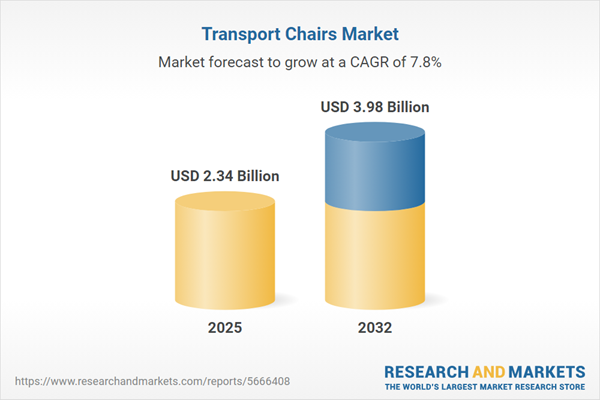Speak directly to the analyst to clarify any post sales queries you may have.
The transport chairs market is rapidly evolving as healthcare organizations pursue mobility solutions that enhance patient outcomes, drive operational agility, and align with shifting clinical and regulatory demands. In an environment marked by demographic change and rising patient care complexities, stakeholders require forward-thinking strategies to ensure readiness and compliance.
Market Snapshot: Transport Chairs Market Size and Growth
The global transport chairs market demonstrates steady expansion, with projections indicating an increase from USD 2.18 billion in 2024 to USD 2.34 billion in 2025, representing a compound annual growth rate (CAGR) of 7.83%. Anticipated to reach USD 3.98 billion by 2032, this growth is primarily driven by a global increase in aging populations alongside the escalation of chronic and acute mobility-related health conditions. Healthcare providers are proactively investing in more transport chairs across hospitals and home care environments, focusing on robust procurement, digital integration, and innovative product engineering to support responsive operations and streamline patient flow in compliance with varied regulatory expectations.
Scope & Segmentation of the Transport Chairs Market
- Propulsion Types: Manual models offer dependable mobility, while powered options leverage lithium-ion or lead-acid batteries, supporting compatibility with facility management software and simplifying patient transfers.
- Material Types: Aluminum frames are preferred for lightweight and portable designs. Carbon fiber bases ensure durability in high-usage settings. Coated steel balances cost-effectiveness with strength. Stainless steel is chosen in environments where infection control and strict hygiene are priorities.
- Applications: Transport chairs are integral for safe and adaptable patient movement across hospitals, rehabilitation centers, and home care, supporting flexible workflows and user comfort.
- End Users: Adult populations gain from advanced mobility features, elderly patients benefit from ergonomic enhancements, and scalable chair options address pediatric needs within healthcare institutions.
- Distribution Channels: Offline retailers and specialized outlets tailor product assessment and customization, while online channels streamline purchasing and inventory management for organizations with multiple care sites.
- Regional Coverage: The sector serves the Americas, Europe, Middle East, Africa, and Asia-Pacific, with regional variations in compliance, operational routines, and supply models guiding local market adaptation.
- Key Companies Covered: Invacare Corporation, Sunrise Medical LLC, Drive DeVilbiss Healthcare Inc., Medline Industries L.P., Graham-Field Health Products Inc., Permobil AB, Karman Healthcare Inc., Nova Medical Products Inc., Meyra GmbH, and Etac AB set industry benchmarks in compliance and product quality.
Key Takeaways for Senior Decision-Makers
- Today’s transport chairs are designed for secure and seamless patient transfers, reducing workflow interruptions across clinical and non-clinical settings.
- Innovations in materials and construction enable lighter, more versatile solutions that simplify daily operations for caregivers and enhance user experience for patients.
- The adoption of powered models with integrated battery systems supports real-time tracking, facilitating effective fleet monitoring and improved resource allocation via healthcare IT infrastructure.
- Modular and configurable chair designs provide organizations the flexibility to adapt rapidly to new care standards and regulatory requirements, ensuring long-term resilience.
- Digital procurement enables faster purchasing, heightened transparency, and centralized control, although in-person assessment remains critical for standardized quality assurance across multi-site facilities.
- Understanding regional differences in reimbursement and compliance is essential for sustained market presence and successful supply chain localization.
Tariff Impact and Supply Chain Resilience
Tariffs on transport chairs and their components in the United States have increased operational expenses and procurement complexity. Healthcare buyers and manufacturers are adapting by cultivating stronger supplier relationships, exploring alternate production geographies, and employing advanced inventory management to mitigate regulatory and market uncertainties. These proactive measures contribute to a more resilient and responsive supply chain structure.
Methodology & Data Sources
This analysis draws on comprehensive secondary research, direct discussions with healthcare sector professionals, and expert evaluation by market analysts. Key findings are consistently cross-referenced with third-party industry databases, ensuring a robust, credible foundation for executive-level planning.
Why This Report Matters for Senior Leaders
- Delivers actionable insights to inform procurement, operational, and technology strategies for mobility solutions, supporting organizational and patient care priorities.
- Equips executive teams to anticipate and manage the effects of tariff changes, regulatory shifts, and evolving supply chain needs, supporting sustainable market strategies.
- Provides a strategic framework for executive alignment on compliance and innovation trends, enhancing preparedness for future patient mobility scenarios across diverse healthcare settings.
Conclusion
Embracing advanced technologies, agile procurement practices, and region-specific compliance empowers organizations to lead mobility innovation and optimize operational performance as the transport chairs market progresses.
Additional Product Information:
- Purchase of this report includes 1 year online access with quarterly updates.
- This report can be updated on request. Please contact our Customer Experience team using the Ask a Question widget on our website.
Table of Contents
3. Executive Summary
4. Market Overview
7. Cumulative Impact of Artificial Intelligence 2025
Companies Mentioned
The companies profiled in this Transport Chairs market report include:- Invacare Corporation
- Sunrise Medical LLC
- Drive DeVilbiss Healthcare, Inc.
- Medline Industries, L.P.
- Graham-Field Health Products, Inc.
- Permobil AB
- Karman Healthcare, Inc.
- Nova Medical Products, Inc.
- Meyra GmbH
- Etac AB
Table Information
| Report Attribute | Details |
|---|---|
| No. of Pages | 193 |
| Published | October 2025 |
| Forecast Period | 2025 - 2032 |
| Estimated Market Value ( USD | $ 2.34 Billion |
| Forecasted Market Value ( USD | $ 3.98 Billion |
| Compound Annual Growth Rate | 7.8% |
| Regions Covered | Global |
| No. of Companies Mentioned | 11 |









